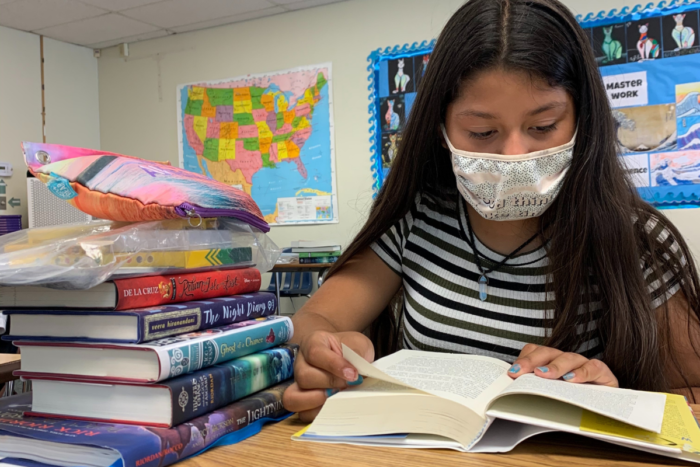
Brave Journeys: Free Resource for Teachers and Counselors
Guest blog post written by Susanne Marcus, twice president of NYS TESOL. She recently retired as ENL teacher for the Great Neck Public Schools, where she continues to offer PD, and teaches in their intensive summer ENL/SIFE program.
The safest place for my immigrant students to explore their emotions is in their English Language Learner (ELL) classroom, the one full of others who are facing the same hurdles and challenges. In ELL classes, it’s an unspoken fact that each student has taken a deep journey far from loved ones, only to arrive in a new place with new ways of communicating, of eating, of dressing, of being. Depending on where my ELLs hail from, their stories often share common threads: separation, loss, anger, disappointment, confusion, depression. They’re often flooded with emotions that are usually too much to contain while trying to decipher the English noise around them.

Building Trust in the Classroom
As I develop bonds of trust with each student, and trust is developed among some students, their stories unfold in pieces, in moments, in flashbacks, bus rides, or in conversations. Yet outside their safe ELL setting, their stories are not reflected on school bulletin boards or in their required reading activities. Nevertheless, these students are expected to make connections to these texts. In fact, new teaching strategies ask students to make a “person to text” connection or a “text to text” connection.” With most curriculums including literary works that were so far removed from my students’ lives and prior experiences, finding that type of connection was tough, even for me.
Building Trust Through Storytelling
After struggling with the curriculum, I came across Brave Journeys/ Pasos Valientes, a riveting anthology of short stories written by immigrant students. Filled with authentic stories that helped my students see themselves as a writer, I have learned that many districts on Long Island, where the book was born, have integrated it into their curriculum. The best outcome is that many educators reported that it has enhanced school performance and social-emotional literacy in dramatic ways while helping their teachers and counselors to get to know their students.
Free Study Guide Resources
During the height of the Pandemic, the anthology’s creators at Herstory Writers Workshop put together a web-based study guide that includes downloadable PDFs of each story in English and Spanish, allowing educators to use one story at a time, to fit divergent curricular needs. The online format allows schools with linguistically diverse populations to use only the English version of the stories. This online format is also helpful should schools have to revert to remote instruction.
Take a look at all that is offered in this study guide, from videos of the student authors reading their stories, to pre- and post-reading activities, to slide presentations to use with the stories, to reflections and tips on how the stories can be used in counseling settings, and more!
Add Brave Journeys to Your Classroom Library
Everyone working with young people should read this book if only to read a few of the stories about pain, loss, strength, and resilience. Told in authentic voices of raw honesty, the stories bring the human condition back to the top of our pedagogical goals. Now more than ever we need to know our students’ stories and past experiences and for it to be reflected in our curriculum. For those who do not work with ELLs, reading these narratives will bring you closer to the realities you may not have previously entertained – realities about your students’ families, how they struggle despite seeming to be “fine,” and how difficult life can really be.
Some districts, unable to fully integrate the book into their programs, have had great success just sharing a story or two from the anthology and report deep impacts of this sharing. Read it for yourself to enrich your teaching practice. Yes, you will cry, and yes, you will smile at the innocence of some stories while embracing curiosity about what has happened to the writer. You will see others in a different light and realize why it is critical to know our students, maybe even more than to know our curriculum. The potential rewards you’ll get from gifting this book to your students are infinite and will reverberate far beyond any curriculum or school walls.
Susanne Marcus brings over 30 years of experience in the field of TESOL to share. A two-term past president of NYS TESOL, she recently retired as an ENL teacher for the Great Neck Public Schools, where she continues to offer PD, and teaches in their intensive summer ENL/SIFE program. As a facilitator for NYSUT, Marcus writes and conducts ENL seminars for NYSUT’s ELT. She has facilitated storytelling workshops for secondary students using strategies from The Moth Storytelling Workshop and Herstory Writers Workshop. Marcus is a frequent presenter at national, state, and local TESOL/BE conferences.
Join the Network
Educators can join First Book’s network — the largest and fastest-growing network of educators, schools, and programs serving children in need across the United States and Canada — to bring these titles and many more to your classroom.
This blog was updated with new, free study guide resources on December 8, 2021.
